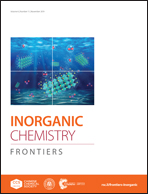Centrosymmetric K2SO4·(SbF3)2 and noncentrosymmetric Rb2SO4·(SbF3)2 resulting from cooperative effects of lone pair and cation size†
Abstract
By introducing Sb3+ cations with a stereochemically active lone pair in the sulfate system, two antimony fluoride sulfates with the same stoichiometric ratio, namely, K2SO4·(SbF3)2 and Rb2SO4·(SbF3)2, were successfully synthesized via mild hydrothermal reactions. The cooperative effects of the alkali metal cation size and lone pairs resulted in a different symmetry for these two title compounds. The compound K2SO4·(SbF3)2 crystallized in a centrosymmetric (CS) space group of P21/c, while Rb2SO4·(SbF3)2 crystallized in the noncentrosymmetric (NCS) space group of P21. Though both of these two compounds consisted of similar structural building units, [SbF3O2]4− tetragonal pyramid complexes and [SO4]2− tetrahedra, they displayed discrepant helix columns in the crystal structure due to the different steric hindrance forces produced by the alkali metal cations. The alkali metal cations K+/Rb+ provided a charge balance and connected the different helix columns to form the three-dimensional framework. The detailed characterizations revealed that Rb2SO4·(SbF3)2 was a potential ultraviolet nonlinear optical material. In addition, theoretical calculations were performed.



 Please wait while we load your content...
Please wait while we load your content...